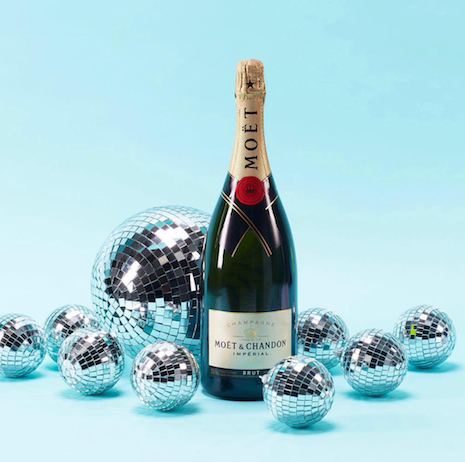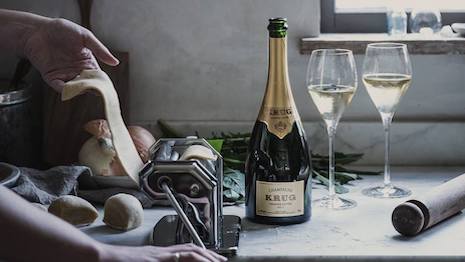France is estimated to consume 102.2 million liters of Champagne in 2021, but such little geographic diversification can be harmful to the economy of the sparkling wine industry, according to Euromonitor.
Understandably as Champagne’s country of origin, France’s forecasted total volume consumption greatly outpaces its European and Western peers. Unlike other spirits such as Scotch whiskies, Champagne has not yet witnessed a high boom of interest from emerging markets.
Bubbly boom
According to Euromonitor’s “Fine Wines/Champagne and Spirits in France” report, France accounts for half of global Champagne consumption.
Unlike other spirits that have diversified geographically, namely in Asian markets, Champagne remains narrowly focused on Western Europe. Per the report, Western Europe accounts for the vast majority, 75 percent, of global Champagne sales.
By 2021, the United Kingdom will consume by total volume 22.6 million liters of Champagne, while the U.S. will account for 20.5 liters of bubbly.
Elsewhere, in countries such as Australia, Japan and Germany the total volume estimated is much lower at 16, 10.7 and 8.4 million liters, respectively.

LVMH-owned Moët & Chandon is produced in France's Champagne region. Image credit: Moët & Chandon
Italy, due to its Prosecco sparkling wine market, will only consume a total volume of 5 million liters in French Champagne by 2021.
The penetration rates of Champagne are also concentrated on a very small fraction of markets. France, in particular, accounts for 49 percent of global volume sales while the U.K. only makes up 10 percent.
Euromonitor points out that there is significant risk in market concentration in case there is economic downturn in those countries. If financial troubles strike, high-priced, often celebratory Champagne is most definitely the first discretionary luxury be cut out.
But, due to consumers’ penchant for experiential luxuries, Euromonitor suggests that fine wines, Champagnes and spirits will outpace hard personal luxury categories in terms of growth.

LVMH-owned Krug Champagne often hosts themed pop-up eateries to tap into experiential luxury. Image credit: Krug
Global sales of fine Champagnes will rise by an estimated 7 percent in U.S. dollar value terms for 2017 as consumers continue to emphasize experience and lifestyle over material goods. With this trend likely to continue, Champagne brands must take a more proactive marketing approach.
Although major Champagne brands are visible on social media platforms, the category lacks the investment of other spirits and luxury goods players needed for worthwhile engagement, according to a new report by L2.
Due to a lack in social media investment, even Champagne category leaders’ efforts are diminished by the likes of Jack Daniels and Chanel, two brands with the highest social media engagement and reach across channels. L2’s “Champagne: Social Media” report suggests that the brands dominating the social conversation are largely due to spend and pay-to-play strategies (see story).
{"ct":"y+UKmXr5GWd3J7ior+KeCEhknxS5lLYeEk8k7rRJxbJb\/ehLflQVkC0sBdLFyk0VuHUJyDPcMqCusJiwyp8BfTvOSTykRbuAkxTEKn1lpxoUBiPG4MiG7As3hoQfYSaEBlwGz5UvPFc3Ax86YjLtjXRnCW4hIF5kr1kZBjRQ\/MjsYButAOMHGeJX5xbzpKFFAYDecms8c44QUBW6hXrg79LDZE8d+e3DbfEePjn9ZnQpS2clX2lpZ5yJBrgHPojlujbwV5OojNxw7wfdRfgSbmsbdOJljRhGJix38hCX32ONHFoZdUer9fogS1J5XKtdXl4mbUfJ8Q6m2G\/NrUF5UHxKvFIeP7uTYatKYR4QxOfaZY40p0s+8TIi8cBhAlOliNDqKAKx15SFMU082\/1vKEfRCNy8DNXVrbXrmkcrHRfIz+1OZAw+\/56CK+Q4u0yfzKeNzImtuVF5drS5q3+5nYP4M6GswlVC2jMUz79nB\/\/P9UYXanzdcrrR0GjD5Iw8L2fOCm73RH3jYrVu3\/OU3ZfkjWQ1oML5i9ThJmCqtLt6xEkitV1DaRDZDMnbDPvkSQAH7aTcLvyFiEcnzbCqAJ41usSpnebPHL1D2uM8takNAPlSVhPr9X+BmvICBKOoIAMAiNm0gvFPQsaBWANVHYy\/DT9dYhAQ6TU0ztwGH9fTd6CSbjdI\/bMoqZ+6cTYC7rEu35fuNRbFfiLr9ai1FrXCK8HCupVKsw\/r1I2+V5cah4JiaRuCFM4ocbbIas+BYVcsHAd3zlON4SRMscjOM7P3qX+sHl1HyHVOfT3pblz0tQYEddSOCcStrzmyPxr5Q9J42zMIFH4B3Nom2+s7qyPxKR6Rcm8biHGtOlf4RAqdv9qV0uOzEqel5XxIppTYw\/lyqDIp0WkyT7HtTUYxmX1lr0uvGj84975WMweRofD9hvkiUmx7hQpcHJ\/YJFzQlpdorJtgkXBl4038Dx1Q7jUTchY4nchLxzKnleXZ7Ojb31eSS9D5DT5GHoQ2HVuVp+wDCQwVWZwPbPzYLrL7APuCnELLMloB0q7IbJIwd09MNmt2Uu2hLueWA9iuTvwp91oVM05+UcpYrmNlXsObe5lbC+YwBvxllFgn2oJpfVM\/HoTJRJg8FHLBdrtlVmrrEXv8S4nz3sdI6LpqiKg9bnA5lrdOUeYOIRkdtu5cdGjge6L6HR0Budch8Z8hqMCNN+YnrKxomr8O6U+tpzfPzO6XqyTomtS1GlooQiF33Dr98eDFVE71Y69IZCYAnCU9P7o76jfQVufbxb8W1VAzi4BOI1JFNU9F+pEDKUsSnxqWoEfzn1XNw3JEhV5VZ580wJK9RaR+t5hBdjG51UgA1h\/mH\/JOe3OCBmlGvCH02+B+z0OwMSwC\/+ck262abDJI69WpYACTjQ2QLJ9OubefVJMfqVCbAqFutdW\/9G7vl33qQPmZBCT\/bm6+fiJvL2RNRH874lFFK+RnG8fo5pqkVVZCM3XQphsfi2kvlZb+6MZGfLzQzcw53kvIqTW2eKBS\/l0ZTDJX47TvZ7RJ+pmE7lU3NufmH5W0vRdYmOv4t9ixjHOH1RRBS5cYDNpHiHmEq6rYR+MisrUlMSyVGHdjEaang8gCknPuzmkQ2XKs409yNW6CbBnaHxa34ds2Nixy9DnzFT3f2SAXOCjZaq8JfIlog3EtfKf1eendg5zKaS\/A9PL53fwoLbGw2gQ9L6AesIX1P2XJKyV6wHGsntv\/JJpXQxN9lPyzP5HN9ihe+Oq2eU7mMQcwNcyRpW720XJ2yTPKH9p\/hsQo\/YvnB9+6ehCcSMkZANesZflO1\/RlvxoAmEIfwkXz1JW1NOmS5S8nEO7d0sFXwhwtOi2vNhl5XKrCS1wcAI04HFY\/pi1pUYTiOLgOsJQw05dgw6SIAAX7yDlXt31vSMSRzDq4H5GvGonBNpvrGxL8bKF7BazeGLdXNDTK3qhnH5H377bmZNcoRLb6tvLLXpIi2D2PPY82ESjECeTul0N\/FGrq3lm5gtUDRDceWbB5Eyu57kYc7ZXlAkWLMxtO3MTXdMIlDOcvpqXjiSY3VdiBj9gjvNNiNbGKbh6cqTUsbN3DojenFUgFKfh7wgeU95PfapdFiqAnukVnUa0rP2Fd8hsappDc2RaOUyydamfj9bINZTP7295gB2Md62tdKWunSeB2NcHSHmT1MlBFuskG9O7Iz8dMVAEBPUlRsQVqCPXXFy39K3WAwxjiEWn02vLiUOQysz6nUXPKN8wUT1xb55L4QTJvKpquSpJfx9AxAqJa5uGSWowouaLzQWmIAt4PpPEAUb9Z4RYZuJbQPlhwHTkhIEFGXuLARefGm9O4QQ9aUpIcGrRXoNdgL2MxcwararEl\/sK3aJZ+hdOZw2TqOw6qpwTvrDqRFmvK6OB7E4AXF4eaQQXdxwTwJpB18Wh4g633\/CbFfnKgjD9VuqTisz0tMVYPGI9f7GBmEQW8yiXR7ByTQV77C7lFGUgfo8qog7Uv9TVxpZAByISe7R1C1eYX0dwOT30\/SfqyG\/hSNXPJ6+WQKH\/oKTZJVgxW5JemvF2\/iK2KNKrgcdxFoHQQFeBToAQtH5ymRXGAWVZkMdBT9GO4mIPj170jLB105LnjMLv0V7pw5cRrB5xM9trPigluDZvSITXsc4ugp4xnBef+PJ5SNPNa548pLXaZom\/Ux1Vvr9pyNsc6ql7ZCglEL4KJT1FYG8bsrIAjFUJ6jUKYf5c2d6rL9KZUwafAbR75rvXNYLHOeKQOqhKb4K+zZSXrvsT5EQNLSJAI8JPBd9eAOoDrIE1Fz2hnGKyE4WbJfUqaMOrkG1MhcFg8EB3fG72Z5OSYV1cz+mkjDlsNnFc+IPJN9fPBLIpBr46b2TYnH8DUJMW\/voYqJoN5lxvlC\/ysB7mBMX2e7hymuO43rbsUJuHefSAGPb3qt0J87epVQ6kVhpq74+e9Lq87L0BnVgRo\/15otDv1sOunce+LpcMPXC\/GwLZI3mazEusOunL9tNw9yl\/gcDBAGf5mh7uHiW+5oAYLlcZqqSwj5zckbwkivgGmM5UpvEIrQRp73WlISDWrVHtdXndFZbYt6GuSMZliqsOIUmy3GO+TVnKmGukHkLNwYgIzFBC6PmWZQjzyPlKyA23LzkteYNuw7QuSnvK499WzZ2sw\/A2hX9g47TEJs9U2JAwOmKIoID44NE2CGZKhIqp93Cu67QJ4ZlHyC0h67BGFUDzuNckP77effOpDvIPTydDT7fFknVF+b4sWGPdQ2zJ+SnZFpGegBu7sxpSz0jF0Y7ueUQoUFHwQMArRCjsFy7EOaEU20VXFT5iNs7XoQysxKwGtMzAZVFl7Hv6wdUCthJwZkdY0duZRq95GPlG5yInTID2paM5cXOUhSA08wP\/Qm45yCI\/TbFwD9Kcukbs0BBQqM2xL+750Z2Q\/zIfeaATZpwG4k39\/YT0kvhMhdVb6c+rFJdVYM9dEhF6u7w293P04VOxPOPxtrzL+8LwtzJ5aib\/5M+fQaJkg4HH1csEHwdWJOYq73f4RDN2ixHWyz+sGIwROQx90\/bunhGq\/JtE1lBIfj5Ym\/lwe3wV6fgF0P5v4+CCvp7gO7tg8jXIvqEfWhEXX1Mvp6IwW74Ye3GLvnmSx7+ExsslSwTjAIqf7of8Clhq4bk0qnbhdz0aiZDzRK+K4VEs+ZRqnMEcTVP32NVe\/N6WvFK7adHIBa6wY4vxDgo2QVIl15AcONQqDVO1+yy05suzPZzAquVHpmys4rGkdFTNs0Ru6FwCaXnCwXzmO85rwNtJnAlTbuIqoRNNmn1F+ZwbHb5ZOy1QuFByIUXTayNeemzb72wWVo\/bljNAwiCiqE5mYCFr5ZC2oGk0dKKXx9YF3iNUr01pkV3TIZ74PxalLSTSU\/gbr\/RtR5iiCFNqeIhN1ZG3oHYKLxY9D7EojC8Sz22vQM6aBuZH9s3yBTH4+HvBpY\/rhnzBSBdP2TjYPIqbelzIFMzAUtNNcMSHiZ7kc00F5VpqqKXcynbuwS\/5aUdROoKt1H0JjCuADlj+TPnOVXmbJPO80BBWowTahmsu5OFNlK6mx+1PfZmA1kt45DY+5ueW9nfHlq6CiRums\/oKh\/oZq1DueN98TC9UdSleJll0ITPhLiPSbwEZ5K5NVEPDpfHZliAGaYyH\/OK\/R+cV7BrLr98FcLjm2\/VHWPeF3N0ep+OljRGwIL98BP0nCX+88WBpX08b+JI+Jvz1Ne7eTEXQLXgI0\/eftrpt9MobXDujORv\/ih3U6KKAbKhCnXJM5r2O5nrYf+CtY+Qdrp+lWe\/4\/TFY2w6D9AZvxJ67VvTN\/7U5bDIABgakd9kqNN1r+4LyoK0eFkP5uHYOCg6\/uT7rUTc4l0u7UZVL1IIubWzFY8+cgqiOJvViycWJZLFASZEGMDWZLGit+8M98FgLRuaKAbbQStjfVwUlqEEmuusbW6VtH2mobHCyvY824AqppPzTEW9tLyKkGTdwdF4C+WArxPwO4M6B+x\/T9i29ZjX3ZkLTCqoPdxyyfsAtPlMA\/7NAx9\/U0Eu5kYxE3uTHhESUU1jnhijAaAwmRnvzN7QPycWnQy5jcp278Ge15SzVA5k8Ebt6RZUE5y0B41rPpe59zA3yzBbwFP14EqFfpMnxXpGvn+kYa3dPRsGRyGgR+zIS8gr89EabpblYYrc0xe43TzT7hRKPp97StWPvEZW\/28IENSOUBAjBBrx1sX7h4Uf88+zTNaiZTI0zVsNk0\/OZUnse35RAa\/9ZvbDse5Y+U7d2fJAtuHep6A6hPHpGkrB6uHX1ILhyD5HMy4qq2UPGaGrcwpOeGAsDmXp5Zhx8F7jRIYUeJw6kV78K7w9dd2pLoalZdVb2OeNgQV4QJBgOOH8Fdf0Mb5PdB5s8sgtVQ1HI7Zc4TkpNLIs1rD2KpX+U7066481liyxjLVR35Oz\/y5f94BJRLU+sWoWb\/EL+2UIQpJkCFW16hdCYMTZfBbq6oS9ekcOpWcoIQIw4855zZ81A5tGixtmTj2+Ns8TIHiD9L084lAbXk3MwYkDUoZDuZFuhpESXqowfOjcptIgYmoS70deBj9XH5F\/XLWt+3TYDQZWv6ZqAtMKzxXMBKnkL+fgKFNBrogt9f3po7pH5Eqdz9JdjYoR9FtdKXvcV2W4ZSWnHF0xZ78OpDB\/dwOxdpWcFmdJWKGCh27GoVB90s5O95Y7xaMTPxr+LU+J2C4agn1Xzxb1DDiqBsnMf67dTBo+iTVTkxgmU7MHst1auqnpVOxCAs2iJbTUggcxaLm9zBl1SXjI3L6hdQVj095bEMVYaxwVxTw+rpbMfRGHiaR7tJMpi2WfDiIDNI\/FDqt3V\/\/DxHB3w4b8pOYDoAhp3tNcL+j+n4yaC4mp85nYx0Tj4e2++MqsgY5WoJkZiDBHKzzVI0zJJcKo+MoCTKgOOsDpQsIXzUFLZgaq\/6iOhzjBDSw8AsY8s5xrd57gcEK7jgevUM4tnl375KnprzvN0hjl9PdYghqj7yVOtWLXHzVVpSa2vdklZ+MKR7avy3bMCsheVOFvbshP6Hq6rqN1N4zN5PwWosK30V+Hw0H9CwjX8CNHngcRlL5P07OwVfumUvXvCb5F3SgVemSTIx\/FoNTXDRpVQexDlghTyVCYDQ1dAkHjA=","iv":"f5680c9b29e57c3b4e5d32d517784fb6","s":"c49806fb6e807063"}

 France consumers the most Champagne. Image credit Moët & Chandon
France consumers the most Champagne. Image credit Moët & Chandon